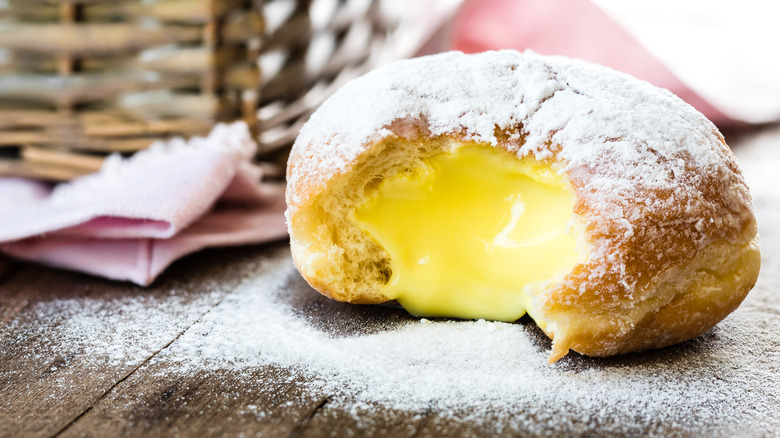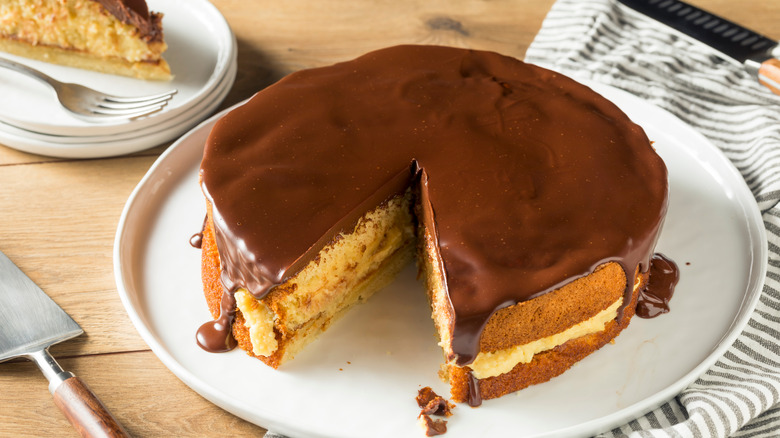The Exact Difference Between Bavarian And Boston Cream
What's not to love about donuts? These fried dough balls of perfection come in a box of a dozen and can singlehandedly carry you through a down day. While there are as many donut varieties as there are stars in the sky — classic chocolate, cake, cruller, maple frosted, blueberry, etc. — a lot of donut aficionados go for the filled kind.
Jelly donuts like sufganiyot have their own long histories (even being part of religious festivals), but what about the cream-filled kind? Well, if you're going for cream donuts, you have two main choices: Bavarian cream and Boston cream. But while they're similar in a lot of ways, and the process for making them is virtually identical, these two varieties aren't quite the same. While there are multiple points of divergence here — the ingredients are slightly different and Bavarian cream can be eaten on its own along with being a filling — the key difference comes down to one thing in particular: The texture.
The texture is the biggest difference
Both Boston cream and Bavarian cream are egg custards with a smooth consistency, and both are made by mixing all their ingredients together and whisking like mad, then cooking them on medium heat while stirring continuously. So far, so same.
But the ingredients themselves present the first difference. Bavarian cream involves milk, eggs, sugar, and often vanilla extract, the same as Boston cream. But then the two ingredient lists diverge: Bavarian cream includes heavy cream and gelatin, while Boston cream involves cornstarch. Though this doesn't have a huge impact on flavor, as both are essentially vanilla custards, the texture varies wildly. The use of heavy cream and gelatin means Bavarian cream sets more thoroughly, creating a thicker, richer consistency. Using only corn starch, meanwhile, means Boston cream is a lot runnier — but it also has an extremely silky texture that Bavarian cream can't match.
Additionally, they're not even eaten the same way. Bavarian cream doesn't have to be part of a donut or a cake to be consumed; people will just eat bowls of the stuff owing to its thick yet light consistency. If someone did that with Boston cream, they would catch some very sidelong glances. (The other difference when it comes to the donuts is the toppings — Boston creams are chocolate-glazed while Bavarian creams are topped with powdered sugar — but we're just talking about the cream here.)
Bavarian cream is a lot older than Boston cream
The origin stories of Bavarian and Boston cream are decidedly different. Germany is a bit of a filled donut haven; there's also the jelly-filled Berliner (aka the thing that people mistakenly believe caused John F. Kennedy to accidentally say "I am a donut" in German that one time). That said, Bavarian cream donuts are undoubtedly more well-known internationally than Berliners — and they have a correspondingly long history. But Bavarian cream is more often associated with French cooking despite its name; the theory is French chefs at the court of Bavarian rulers in the 17th and 18th centuries learned the recipe there, then brought it back to France. Whatever the case, it's been a French dessert staple for centuries.
Boston cream, meanwhile, has a much more specific, if disputed, origin story. Descended from similar "pudding-cake pies" common to New England and Pennsylvania Dutch territory, it was supposedly created by a French chef named Sanzian (just "Sanzian," like Cher or Pele) at the Parker House Hotel in Boston in the 1850s. There's a debate over this, though; some food historians believe it was mentioned in the New York Herald before the opening of the Parker House, while others think its existence can't be confirmed until decades later in 1878.
Food origin stories tend to be messy, but one thing is certain: Both Bavarian cream and Boston cream are the delight of donut lovers everywhere. Just don't mix them up.


